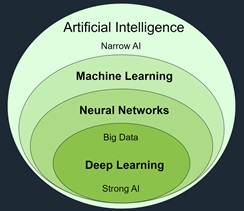MyAI

Artificial Intelligence
Artificial Intelligence
By Sunil Marella
Artificial Intelligence Types
Based on Capabilities
- Narrow AI (or Weak AI):
- Purpose: Handles specific tasks or problems.
- Characteristics: Operates under a limited set of constraints and contexts.
- Examples: Chatbots, recommendation systems, image recognition software.
- General AI (or Strong AI):
- Purpose: Exhibits human-like intelligence and understanding, capable of solving a wide range of problems.
- Characteristics: Can learn, understand, and apply knowledge in different domains.
- Examples: Still theoretical, no existing examples.
- Superintelligent AI:
- Purpose: Surpasses human intelligence across all fields, including creative, emotional, and social intelligence.
- Characteristics: A hypothetical concept where AI would be capable of outperforming the best human brains in practically every field.
- Examples: None, purely speculative at this stage.
Based on Functionality
- Reactive Machines:
- Purpose: Focuses on current scenarios, reacting to them in real-time or near real-time.
- Examples: IBM's Deep Blue, Google's AlphaGo.
- Limited Memory:
- Purpose: Uses past experiences (stored data) to inform future decisions.
- Examples: Self-driving cars, chatbots with contextual awareness.
- Theory of Mind:
- Purpose: Understands and interprets human emotions, beliefs, and intentions.
- Examples: Still in research and development, no existing examples.
- Self-Aware AI:
- Purpose: Possesses self-awareness and consciousness.
- Examples: Purely theoretical, no existing examples.

AI Concepts
- Narrow AI: It is a type of artificial intelligence designed to perform a specific task or set of tasks. Examples: Voice assistants, Spam filters, etc.
- Machine Learning: Ability to learn by using algorithms to discover patterns and generate insights from the data they are exposed to. Examples: Fraud detection, Predicting customer churn.
- Neural Networks: A type of machine learning model inspired by the structure and function of the human brain. They consist of interconnected nodes (neurons) organized in layers. Examples: Handwriting recognition, Facial recognition.
- Deep Learning: Subcategory of machine learning, provides AI with the ability to mimic a human brain’s neural network. It can make sense of patterns, noise, and sources of confusion in the data. Examples: Self-driving cars, Generating realistic images and videos.
- AI is the broader field: It encompasses various approaches to creating intelligent systems.
- Machine learning is a subset of AI: It's a specific way to achieve AI through learning from data.
- Neural networks are a type of machine learning model: Inspired by the brain, they're used for complex tasks.
- Deep learning is a specialized form of neural networks: It leverages many layers to tackle even more intricate problems.
Disclaimer: This is purely based on my learning, knowledge and reference from tutorial / documentation.